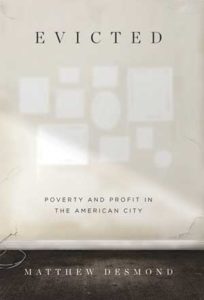Evicted AND Dream Hoarders
Reviewed by J. E. McNeil
April 1, 2018
 Evicted: Poverty and Profit in the American City. By Matthew Desmond. Crown Publishing Group, 2016. 422 pages. $28/hardcover; $17/paperback; $12.99/eBook.
Evicted: Poverty and Profit in the American City. By Matthew Desmond. Crown Publishing Group, 2016. 422 pages. $28/hardcover; $17/paperback; $12.99/eBook.
Buy from QuakerBooks
Dream Hoarders: How the Upper Middle Class Is Leaving Everyone Else in the Dust, Why That Is a Problem, and What to Do About It. By Richard V. Reeves. Brookings Institution Press, 2017. 196 pages. $24/hardcover; $17.99/eBook.
I am not sure when I first became aware that there were (at least) two economies in the United States. Maybe when my client got to my office by three buses instead of one DC Metro train because riding the bus was so much cheaper. Surely when my receptionist quit paying her rent and waited for eviction so that she had enough for a deposit and first month’s rent for her new place—a tactic that never had occurred to me.
These two books reflect those different economies. The one you live in and the one that others live in. Evicted is primarily how the poorer economy works. Dream Hoarders is about the economy in which most Friends live and how we help perpetuate the other economy. Together, these books paint a grim picture, but also give a glimmer of hope.
These books are not focused on racism—they are about poverty and wealth. Ultimately, however, they are about the enduring burdens of segregation and red-line districts.
Evicted, through the fascinating interwoven stories of renters and landlords, tells how eviction has become so profitable that the process has exponentially increased. Tenants are trying to survive a system that is not set up for their survival. Neither good nor bad choices seem to have much bearing on their quests to live in acceptable housing, have enough to eat, and provide stability for their families. In a society that expects people to spend 30 percent or less of their income on housing, some people spend 70 percent or more of their already inadequate income on housing, leaving only a few dollars for food and emergencies. Any emergency means not making the rent and—eventually—getting evicted from their already inadequate housing.
Or maybe not—who gets evicted depends on the caprice of the landlord. A person who complains about rats and holes in the walls and owes a few dollars is more likely to be evicted than a person who passively accepts the horrors in which they live. Anything that brings the police—including complaining of being beaten by their man—can result in eviction. Going to court to oppose eviction may mean the loss of the inadequate job they cling to. A person who is aggressive in the face of demands (usually a man) may be left alone; another person who just tries to avoid being seen (usually a woman) may be evicted instead. Desmond writes: “If incarceration had come to define the lives of men from impoverished black neighborhoods, eviction was shaping the lives of women. Poor black men were locked up. Poor black women were locked out.”
Those who are evicted find themselves in even worse situations. Furniture, clothing, toys, and food are abandoned, stolen, or destroyed. Court notices and appointment reminders go to the wrong address. A person cannot get an apartment in a better, safer place with an eviction on their record. Their children may have to change schools. Depression may threaten to hang over the whole family. And in most cases eviction leaves the evicted person with insurmountable debt on the court records.
You’d think the insurmountable debt wouldn’t matter—after all these people have nothing that the landlord can levy or attach a lien to—but it does. There are companies that profit by watching to see if the evicted person ever comes into money, for instance, from the final results of litigation over the accident that put them out of work, or from finally crawling up from the depths of their lives. And then one more time they are smacked down, and the money they saw as their salvation disappears, in whole or in part, along with their hopes.
Desmond argues that the federal voucher system where individuals pay 30 percent of their income and the government pays the rest works and should be expanded—an unlikely result in today’s political climate. Although it is clear that the individuals who found stable housing had relatively happy endings.
But the voucher system pays landlords more than the fair market value for apartments, becoming a veritable windfall to landlords even with the additional “burden” of keeping the housing up to code. Because of this skewing many fewer people receive vouchers than qualify and that could be funded. A December 23, 2017 U.S. District Court decision in D.C. required using local neighborhoods to determine fair market value; this decision may have changed that practice.
All in all, this is a book which illuminates Martin Luther King Jr.’s words: “Every condition exists simply because someone profits by its existence. This economic exploitation is crystallized in the slum.”
So other than being a shockingly sad story in the human family (a rather abstract view), what does this other economy have to do with most Friends? That is where Dream Hoarders takes up the story.
 Dream Hoarders is full of data, most of which is not surprising. There is a widening gap between classes in our country. Rather than call people rich, we call them “upper middle class” and leave that term, “rich,” for the 1 percent. People with money who have children spend that money on helping those children succeed. People without money who have children have fewer choices. There are dozens of graphs illustrating the various points. This is information that you could find in a dozen books over the last ten years. And this, too, is a picture of the legacy of Jim Crow.
Dream Hoarders is full of data, most of which is not surprising. There is a widening gap between classes in our country. Rather than call people rich, we call them “upper middle class” and leave that term, “rich,” for the 1 percent. People with money who have children spend that money on helping those children succeed. People without money who have children have fewer choices. There are dozens of graphs illustrating the various points. This is information that you could find in a dozen books over the last ten years. And this, too, is a picture of the legacy of Jim Crow.
What makes Richard Reeves’s book worth the read (besides his humor) is how he frames and explains the data we have heard countless times since the Occupy Movement in 2011. He is focused less on the 1 percent and more on the top 20 percent—the upper middle class in which many if not most Friends comfortably reside. And he focuses on the things people do that don’t just help their children, but that actually harm other children—intentionally or not. He looks at society in the United States as a zero-sum society in which affluent parents violate some vague antitrust rules by promoting their children’s positions. Finally, he provides suggestions on how we, as a nation, can move toward the society which we claim to have and one where the American Dream is not just a fantasy in Frank Capra movies.
But while his framing of the issue is useful—how the upper middle class profits from 529 plans to fund the tax-free education of their children and how they have created a glass floor—his solutions are not.
He suggests the need for downward mobility without really exploring what that would mean. Must children be impoverished to make society fairer? Or could we focus more on grants rather than using the tax code to provide educational aid to those who cannot afford to buy it? The most recent “reform” of the tax code has limited aid for education, but 529 plans for the affluent are still protected. The extremely wealthy, especially employers, gain. Teachers and employees are written out of the code. Is education even the answer in a society where highly educated people cannot reliably find work since 2008? Can we encourage more people to look to skilled work or vocational education? Can we continue to work to blur the red lines of yesterday rather than just displace them with gentrification?
Two books which ostensibly explore economics ultimately highlight the continuing price of white privilege. Neither one provides a complete solution, but both offer insight into a way forward. Both will make you think.
1 thought on “Evicted AND Dream Hoarders”
Leave a Reply
Comments on Friendsjournal.org may be used in the Forum of the print magazine and may be edited for length and clarity.



Some of the “highly educated” have degrees in subjects that are completely useless economically; why would you bother getting a degree in History or some “Area Studies” or “Communications” when employers want people who are good in STEM subjects?